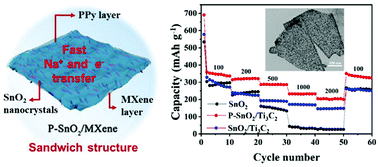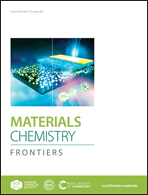Ultrasmall SnO2 nanocrystals sandwiched into polypyrrole and Ti3C2Tx MXene for highly effective sodium storage†
Abstract
The main challenge for developing transition metal oxides (TMOs) as anode materials for sodium-ion batteries (SIBs) is to rationally design and synthesize TMO-based hybrid structures and precisely control the transport of ions and electrons. Herein, we propose a facile in situ interfacial growth strategy to achieve a novel sandwich structured P-SnO2/Ti3C2 composite, where SnO2 nanocrystals modified with an ulthathin polypyrrole (PPy) layer of about 3 nm are strongly coupled with Ti3C2Tx Mxene nanosheets through Sn–O–Ti chemical bonds. Uniformly dispersed SnO2 nanocrystals confined in PPy and Ti3C2Tx nanosheets provide abundant acitve sites, while the conductive polymer PPy and Ti3C2Tx serve as robust protective layers alleviating the volume expansion and fast channels for Na ions and electron transport. Thanks to the advantages of structure and composition, the resulting P-SnO2/Ti3C2 anode demonstrates excellent sodium storage properties in terms of long cycle life (325.6 mA h g−1 at 100 mA g−1 after 100 cycles) and outstanding rate performance (204.4 mA h g−1 at 1000 mA g−1). The density functional theory calculations further prove that the P-SnO2/Ti3C2 heterostructure can balance the adsorption and release of Na atoms on the interface, thus boosting the performance of SIBs. This approach developed can also provide valuable guidance for the constuction of more functional TMO-based composites.



 Please wait while we load your content...
Please wait while we load your content...